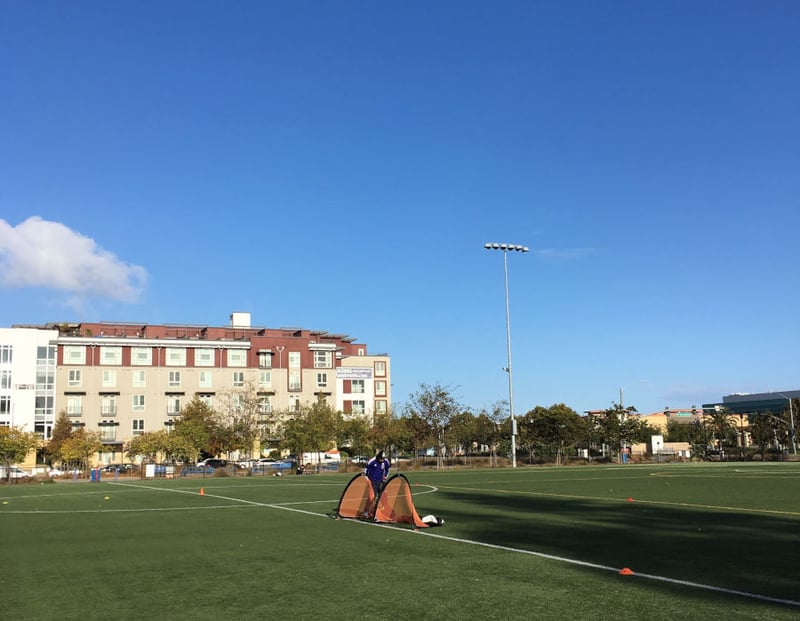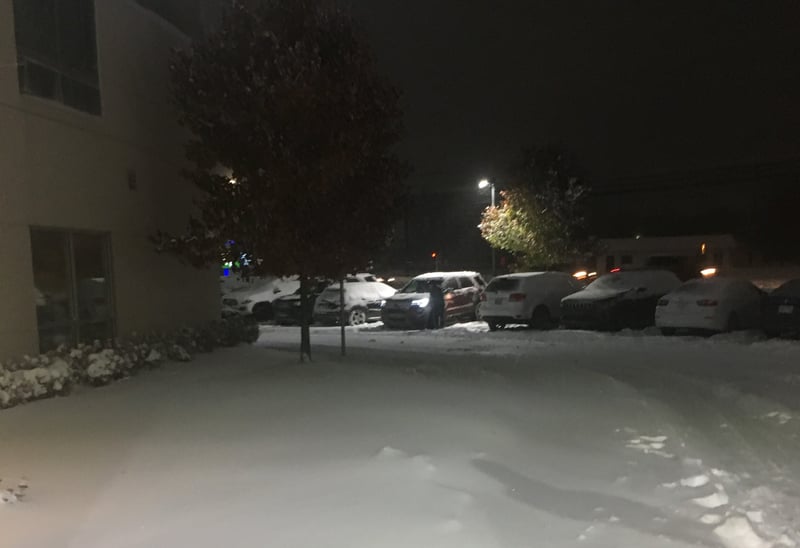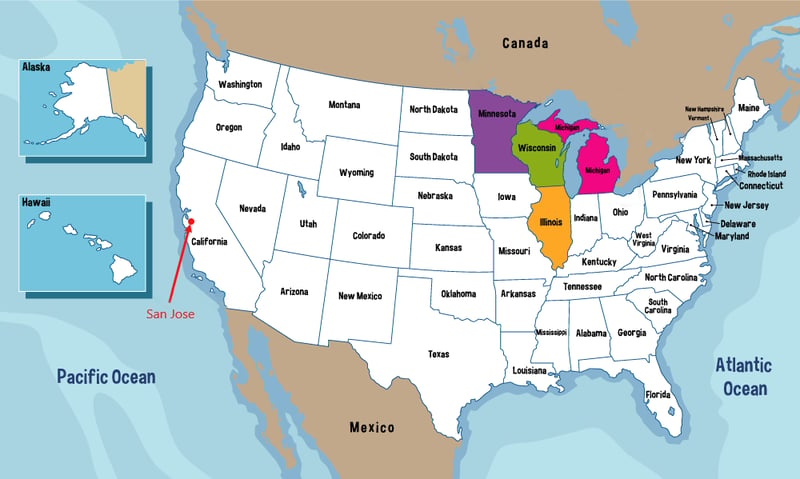Last Updated: December 21, 2023
Click below to read subsequent volumes,
Differences between Japan and the U.S. as Experienced by Expatriates in the U.S. (Part 2)
Hello and nice to meet you.
My name is Kashima. I have been assigned to North America (henceforth referred to as U.S.) since 2017 and am currently supporting our customers in the U.S. as a local FAE (Field Application Engineer) for Nisshinbo Micro Devices (formerly Ricoh Electronic Devices).
I am very honored to have my writing published on the company's official blog.
As I would like to start this series as "hashi-yasume" (meaning a side dish served between main courses in Japanese) blog, I hope you will take a moment to read it during breaks at work or while eating.
★★★
From Expatriates Series
Differences between Japan and the U.S. as Experienced by Expatriates in the U.S. (Part 1)
Well, I would like to introduce myself again and talk about my life in the U.S.
I am currently located in San Jose, California, the so-called Silicon Valley.
The sound of the word may make you imagine a progressive city surrounded by tech companies, but I live in a moderately suburban area. Coming from a countryside, I find it quite easy to live here.
There are many Japanese expatriates and residents, as well as Japanese supermarkets and pediatric clinics.
The climate in San Jose area is not humid like summer in Japan. It is dry and there are very few uncomfortable nights to sleep. It almost never rains except during the rainy season in winter. In addition, I have never used an umbrella in the U.S. because of the car-oriented society. Overall, I think San Jose is one of the most comfortable areas in the U.S. for Japanese people to live.
I have been living in the U.S. for about three and a half years now. (As of this blog's written in Japanese.)
 Blue Sky in San Jose
Blue Sky in San Jose
"What are the differences between Japan and the U.S.?" When someone asks me, my answer is… a wide variety of races, languages, foods, prices, etc.... there are many differences. In this blog I would like to focus on the difference in climate.
Japan is probably known for its four distinct seasons: spring, rainy season and summer, autumn with colored leaves, and cold winter. On the other hand, the U.S. is a large country, and the climate varies from one part to the other. I have learned through my stay in the U.S. that the summers and winters are harsher here than in Japan.
In this first blog entry, I would like to tell a story about my questions about IC specifications that I had when I first joined the company, and the answers that I have found through while staying in the U.S.
Simple question: What is the operating temperature range of ICs?
To begin with, let me talk about the questions I had about IC specifications when I joined the company.
As you may know, it is customary in semiconductor industry that the operating temperature range of ICs is -40°C to 85°C (products for consumer applications) and -40°C to 125°C (for automotive).
On the high temperature side, I was able to imagine that the temperature rose when ICs supplied a large current even with our highly efficient DC/DC converters and linear regulators with low dropout voltage.
On the other hand, however, at the low end of the temperature range of -40°C, I had some questions such as:
"Hmmm? It's a little warmer even in a freezer, isn't it?"
I just thought, "Why not make the specifications better by narrowing the operating temperature range to -20°C or something?"
(Please accept that this was my ignorant question that occurred to me just after joining the company…)
I experienced a truly "extreme cold" winter!
However, winter in the U.S. can be extremely cold!
I felt it when I visited Minnesota, Michigan, Illinois, and Wisconsin in winter. When it reached -20°C, my mouth hurt because of the cold when I opened my mouth. Breathing was also a struggle because of cold air coming in when inhaling. One of my American colleagues said, "Cold is cold," whether it was 5°C, 0°C, or -20°C. While I thought "Exactly," I also thought the level of cold was different....
It was truly the coldest I have ever experienced.
 Photo at a Hotel in Michigan during a Business Trip
Photo at a Hotel in Michigan during a Business Trip
At that time, I suddenly thought to myself,
"Here in the U.S., we cannot use ICs that fall outside of its operating temperature range at only -20°C."
When I visited Minneapolis, Minnesota, I spoke with a sales representative (of a partner company that helps us promote our products), who saw the temperature reading of -20°C and said,
"This year is still better, last year it was around -40°C all winter."

That's right! Having no experience of living in a snowy region, I thought a world of -40°C was just a numerical temperature that was imaginary and never observed. However, a person who had survived through a winter of -40°C was standing in front of me.
(Note: The person is not a bigfoot, nor has he lived outside in -40°C.)
I still haven't experienced a world of -40°C, but…
"Thanks for the ICs that work even at -40°C! And goodbye to my shallow questions during my fresh employee days!"
I wanted to shout like a bigfoot. (The photo is an image, not me.)
For your information, the following figure shows the location of San Jose, where I live, and the states of Minnesota, Michigan, Illinois, and Wisconsin, where it is extremely cold in the winter.
 Location
Location
Power Management ICs that support -50°C beyond -40°C barrier!
Returning to the previous description…
As I stated earlier, in general the lower operating temperature for ICs is -40°C and a story about how I realized that -40°C was indeed necessary. Then, a new concern came up, "Is -40°C sufficient? It would be better to have -50°C ..." If anyone has similar concerns, please don't worry.
We have a lineup of products with the extended operating temperature range down to -50°C.
To predominantly meet the needs of applications for industrial equipment, we have a lineup of LDOs and VDs that support the operating temperature of -50°C.
The ICs with the operating temperature of -50°C offer industrial grade quality for use in applications such as PA field devices used in extremely cold outdoor conditions, sensors and measuring instruments for plants, and so on.
Main lineup of ICs for industrial applications supporting -50°C (Click the link to open the Datasheet)
- For Industrial, Low Supply Current 60V Input 100mA Voltage Regulator, R1560x-Y Series
- For Industrial, 60V Input 100mA Voltage Regulator, R1561x-Y Series
- LDO For Industrial, High Noise Immunity Low Supply Current 42V Input 200mA Voltage Regulator, R1525x-Y Series
- For Industrial, 42V Input Window Voltage Detector, R3152N-Y Series
- For Industrial, Low Supply Current 60V Input Voltage Detector, R3160N-Y Series
Thus, the product lineup that meets our customers' needs has also resolved my new concerns.
Thank you for your kind attention, and that's all for this blog.
I hope you look forward to the next blog of "From Expatriates Series" of U.S. edition.




Comment